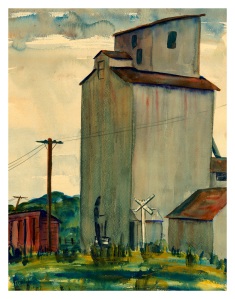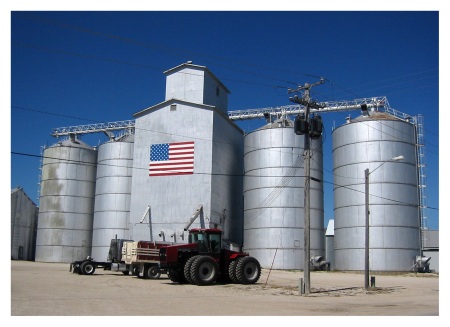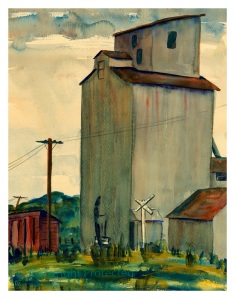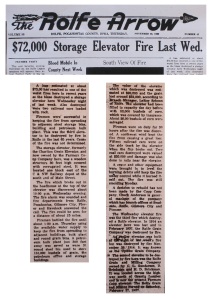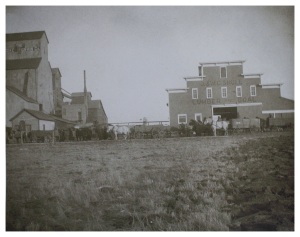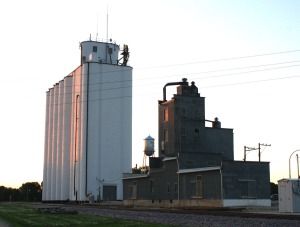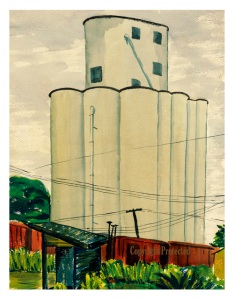In November of 2009 the Des Moines Register published an article about Mother’s (Marion Gunderson) work and her watercolors. The timing of the article coincided with the open house at Bill’s and my Perry, Iowa, home. At that open house, prints of Mother’s watercolors were sold with the profits going to the Rolfe Public Library Trust.*

Pocahontas Grain Elevator II Prints are available in three sizes: Medium (Limited Edition, 10" W x ~12.3" H, $25), Grand (~18" W x 22" H, $50), and Largest (20" W x ~24.5" H, same size as the original, $70). (Click photo to enlarge.)
The watercolor featured in the Register article was that of the Pocahontas, Iowa, grain elevator, shown at the left. The article caught the attention of Arlene Brockney of Waukee who lived in Pocahontas in the late 1940s and is the daughter of Viola Jacobson.
Arlene’s recollection of the grain elevator construction is as follows.
* * * * * * * * * *
Pocahontas Elevator, Summer of 1949
My family lived west across the street while it [the grain elevator] was being built. They worked all day and night pouring the cement. For the workers there was a huge night-light that was also great for evening walks.
My mom went to work at the Ideal Cafe at 5 o’clock in the morning. As she would leave the house for work, the construction crew would holler down to her their orders for breakfast. That way, hot food was ready for them when their shift was done.
When the elevator was finished, my mother and two sisters rode to the top and waved at me. Our lot is now in the approximate area of the parking lot for the branch office of the Rolfe State Bank.
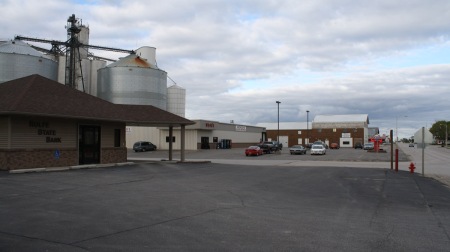
The building in the foreground is the Pocahontas, Iowa, branch of the Rolfe State Bank. As a teenager, Arlene Brockney lived in a trailer that, in the 1940s, was in the vicinity -- just north -- of what is now the location of the bank building. The grain elevator that Mother painted is behind the bins in this photo. The street at the far right is Highway 3 running east/west. The camera is pointed primarily east. (Click photo to enlarge.)
* * * * * * * * * *
Arlene said she was 14-years-old and detasseled corn that summer of 1949. She said that the night-light for the construction crew was like a helicopter hovering. Arlene chuckled when she said that the light did not allow for privacy, making her glad that the elevator construction was completed by the time she started dating!
In the midst of the breeze of the summer nights, while on the ground, Arlene could hear the construction workers above talking. Well, actually mumbling with people below not knowing exactly what the workers were talking about.
At that time, Arlene’s family lived in a trailer on the Pocahontas property that is now owned by Rolfe State Bank.
(Click here to view Part II including what I think is a 1950s or ’60s aerial photo of the Pocahontas grain elevator.)
* * * * * * * *
* * * * * * * *
At this link you’ll see information regarding prints of Mother’s watercolor (shown above) as well as where you may purchase them in Rolfe. Prints may also be ordered online. Mother also painted the Rolfe grain elevator and train depot (two watercolors) and Gilmore City grain elevator and depot (one watercolor).
*All profits go to support the digitizing of 101 years of Rolfe newspapers so they will be accessible online. Hopefully they will be online in March.
Click here to go to Louise Gunderson Shimon’s blog’s home page.
